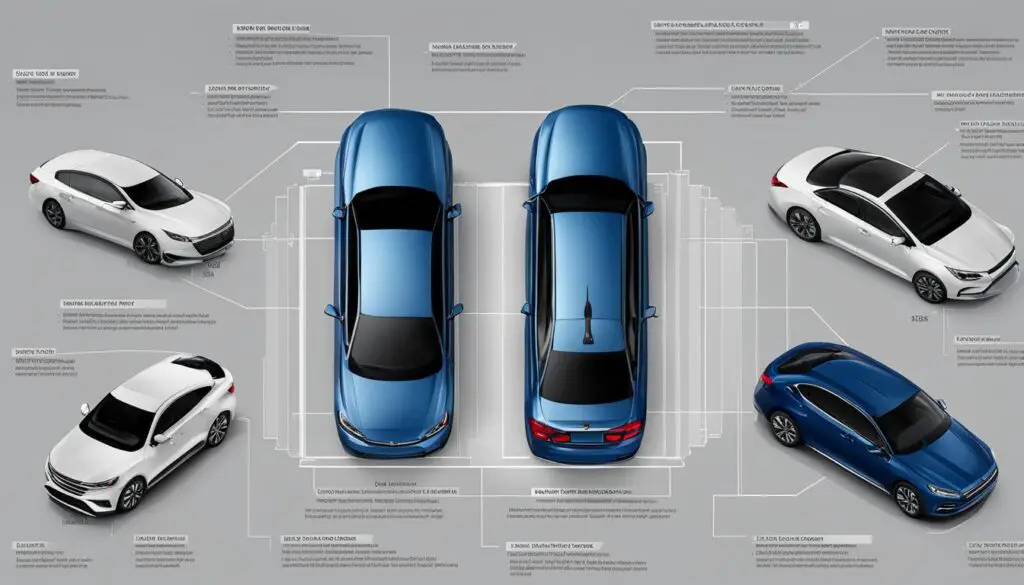
Car Safety Features Explained
As a driver, your safety and the safety of your passengers should always be a top priority. Understanding car safety features is essential in ensuring you are well-equipped for any situation that may arise on the road. In this section, I will provide a comprehensive explanation of car safety features and emphasize their importance in keeping you safe.
Car safety features are designed to protect you in the event of an accident and prevent accidents from occurring in the first place. From seat belts and airbags to anti-lock brakes and lane departure warning systems, each feature plays a crucial role in keeping you and your loved ones safe. By understanding how these features work and the benefits they provide, you can make an informed decision when purchasing a vehicle and feel confident in your safety on the road.
Key Takeaways:
- Understanding car safety features is crucial for driver and passenger safety.
- Car safety features can prevent accidents and protect you in the event of an accident.
- Each safety feature plays a unique role in ensuring your safety on the road.
- Knowing how these features work can help you make an informed decision when purchasing a vehicle.
- Investing in a vehicle with advanced safety features can provide added protection and peace of mind.
The Basics of Car Safety Features
Every car comes equipped with a set of safety features, some of which are mandatory by law. Understanding these features and how they work is essential for any driver to ensure a safe and secure driving experience. Here are some of the basic car safety features:
| Car Safety Features List | How Car Safety Features Work |
|---|---|
| Seat belts | Seat belts are designed to keep passengers restrained in the event of a collision. They work by absorbing the force of impact and spreading it across the chest and pelvis. |
| Airbags | Airbags are designed to inflate rapidly in the event of a collision, cushioning the impact and reducing the risk of injury to the driver and passengers. They work in tandem with seat belts to provide maximum protection. |
| Anti-lock Brake System (ABS) | ABS is a safety feature that prevents the wheels from locking up during heavy braking, allowing the driver to maintain control of the vehicle. ABS works by pulsating the brakes, ensuring maximum stopping power without loss of control. |
| Traction Control System (TCS) | TCS is a safety feature that prevents the wheels from spinning when accelerating on slippery surfaces, providing better grip and control. It works by reducing engine power and applying the brakes to the spinning wheels. |
| Electronic Stability Control (ESC) | ESC is a safety feature that helps prevent the car from skidding or losing control during cornering or sudden maneuvers. It works by detecting loss of control and applying the brakes to specific wheels to keep the car stable. |
It’s important to note that these safety features are only effective when used correctly. Always wear your seat belt and ensure that all passengers are properly restrained. Follow the manufacturer’s instructions on how to use these safety features and never attempt to disable them.

In the next section, we will explore advanced car safety features that go beyond the basic ones.
Advanced Car Safety Features
While basic car safety features provide essential protection, advanced safety features offer added layers of security for you and your passengers. These innovative technologies are designed to prevent accidents and keep you safe in the event of a collision. In this section, we will discuss some of the latest advanced car safety features that you should consider when purchasing your next vehicle.
1. Blind Spot Monitoring
Blind spot monitoring uses sensors or cameras to detect objects in your blind spots and alert you if there is a vehicle approaching. This feature can help prevent accidents, especially when changing lanes or merging onto a highway. Some blind spot monitoring systems also include rear cross-traffic alert, which warns you of approaching vehicles while backing up.
2. Lane Departure Warning and Lane Keep Assist
Lane departure warning and lane keep assist are designed to prevent you from drifting out of your lane. Lane departure warning alerts you if you start to drift, while lane keep assist can gently steer you back into your lane. This feature can be especially useful on long drives or when driving at night when visibility is reduced.
3. Adaptive Cruise Control
Adaptive cruise control takes traditional cruise control to the next level by using sensors to maintain a safe distance from the vehicle in front of you. This feature can automatically adjust your speed to maintain a safe following distance and can even bring your car to a complete stop in heavy traffic. Adaptive cruise control can reduce driver fatigue and make long trips more comfortable.
4. Automatic Emergency Braking
Automatic emergency braking is designed to prevent or reduce the severity of a collision by detecting an imminent crash and automatically applying the brakes. This feature can be especially helpful in situations where a driver may not be able to react in time, such as a sudden stop by the car in front of them. Some automatic emergency braking systems also include pedestrian detection.
5. Forward Collision Warning
Forward collision warning uses sensors or cameras to detect an imminent collision with the vehicle in front of you and alerts you with both visual and audible warnings. This feature can help you react quickly and avoid a potential accident.
By making sure your vehicle is equipped with these advanced car safety features, you can significantly reduce your risk of being involved in a serious accident. Remember to check the car safety features checklist when purchasing a new vehicle to ensure that you are getting the best safety features available.

Conclusion
In conclusion, I hope this guide has provided a thorough understanding of car safety features and their importance on the road. By prioritizing safety features when purchasing a vehicle, you can ensure that you and your passengers are protected in the event of an accident.
It is crucial to refer back to this guide as a car safety features guide to ensure that you are familiar with all safety features and can make informed decisions when purchasing a vehicle. Remember, understanding car safety features is the first step in prioritizing your safety on the road.
FAQ
What are car safety features?
Car safety features are technologies and systems built into vehicles to protect occupants from accidents or minimize injuries in the event of a collision. These features can range from basic components like seat belts and airbags to advanced technologies like lane departure warning systems and adaptive cruise control.
Why are car safety features important?
Car safety features are important because they help reduce the risk of accidents and protect occupants in the event of a crash. They provide an added layer of protection and can help prevent or minimize injuries, potentially saving lives. By investing in a vehicle with advanced safety features, you can enhance your overall safety on the road.
What are the benefits of car safety features?
Car safety features offer numerous benefits. They can help prevent accidents by providing assistance in various driving scenarios, such as maintaining a safe distance from other vehicles or warning the driver of potential collisions. In the event of a crash, these features can help minimize injuries by deploying airbags, activating seat belt pretensioners, or providing structural reinforcement to the vehicle.
How do car safety features work?
Car safety features work through a combination of sensors, cameras, and computer systems. These components continuously monitor the vehicle’s surroundings and the driver’s actions. When a potential hazard or collision risk is detected, the safety feature can alert the driver, automatically apply brakes, or take other corrective actions to avoid accidents or reduce the impact of a collision.
What are some examples of basic car safety features?
Basic car safety features include seat belts, airbags, anti-lock braking systems (ABS), traction control, and electronic stability control (ESC). These features have become standard in most vehicles and are designed to provide fundamental protection in the event of a crash or help maintain control during challenging driving conditions.
What are advanced car safety features?
Advanced car safety features go beyond the basic ones and incorporate newer technologies and innovations. Examples of advanced safety features include forward collision warning, lane departure warning, blind-spot monitoring, adaptive cruise control, and automatic emergency braking. These features utilize sensors, radars, and cameras to provide additional assistance and enhance overall safety on the road.
How can I ensure my vehicle is equipped with advanced car safety features?
To ensure your vehicle is equipped with advanced car safety features, it is recommended to consult the vehicle manufacturer’s specifications and options list. Additionally, research and compare different vehicle models to identify those that offer the specific advanced safety features you are interested in. When purchasing a vehicle, ask the dealership or seller for confirmation and documentation regarding the presence of these features in your chosen model.
